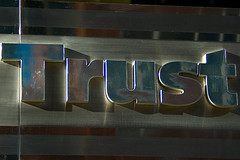|
|
|
Tuesday, July 9th, 2013
“[If people are] frustrated by red tape or by having someone breathing down his neck, someone for whom he has scant respect, if he has little influence on decisions which affect his work, and which he may not agree with, then he will pack up and go. And so he should. It is up to us, therefore, to create an organisation which will allow gifted individuals to unfold.” –Ove Arup
 Arup walked his talk and ran a company that embodied the six basic principles of a great place to work. Arup walked his talk and ran a company that embodied the six basic principles of a great place to work.
- Differences are nurtured, so individuals can be themselves at work and contribute their unique talents.
- Information is not suppressed or distorted, so people can find out what they need to know to do their work.
- Individuals are given meaningful chances to grow, becoming more valuable to the organization in the process.
- The company is a place where everyone feels proud to work, spurring them to go beyond their stated roles.
- People’s day to day work makes sense to them, and they understand how their own jobs fit in with everyone else’s.
- And they are not hindered by stupid rules.
It may not be easy, but no matter what approach your company takes, or what level manager you are, you can infuse these principles in your own group and shelter them from those above.
It’s not easy, but it can be done and the payoff is amazing.
Flickr image credit:
Posted in Culture, Ducks In A Row | No Comments »
Saturday, April 30th, 2011

Do you have a power-happy boss who never heard of engagement? The kind who believes a big title is all that’s needed to run an organization? If so, you might give him a copy of this article; it spells out why that approach dooms him to failure—sooner or later.
On the other side of the fence is David Kelley, founder of IDEO and the Hasso Plattner Institute of Design at Stanford, who explains why, although largely unsung or ignored, empathy is a necessary trait to drawing the best out of people.
Everyone is talking about employee engagement, but what is it really? Is engagement a function of what managers do or is it outside of their control? Matt Grawitch, professor of Organizational Studies at Saint Louis University School for Professional Studies, offers a different view on engagement from most that I’ve seen.
I thought it would be nice to end today on a lighter note.
Have you ever given thought to CEO names? Or the difference between the names used by the guys vs. the gals in the corner office? I didn’t think so, but LinkedIn did. Check out the most popular CEO names and what they mean.
Image credit: MykReeve on flickr
Posted in Expand Your Mind | No Comments »
Monday, November 16th, 2009
 I probably shouldn’t say this, but I do get tired of having managers ask, how to get workers to think/do/work “outside-the-box.” I probably shouldn’t say this, but I do get tired of having managers ask, how to get workers to think/do/work “outside-the-box.”
For decades they’ve been exploring a plethora of business books, articles, seminars, coaching, consulting, discussions, etc., on the subject—some good, some not so good—and are still searching for how to lead their workers out of that dreaded box.
I hear, “How do we get the team to think differently?” “What incentives work best?” “How do we engage our people?”
What I don’t hear is “What do I need to change in me [to make it happen]?”
What annoys is the assumption that the solutions all involve changing the staff, environment, compensation and any other external item that might plausibly make a difference—except self.
If you want your people to think/do/work outside-the-box then you need to lead/manage outside-the-box and that usually means changing your MAP (mindset, attitude, philosophy™) before you can expect your people to change theirs.
This is rarely what leaders/managers want to hear.
I keep saying it, as do others, but many still don’t get it or just ignore it.
Today I’m saying it again loudly and very publicly:
You (there are no exceptions, none) manage/lead based on the way you think, what you think, how you think, and what you believe—in other words your MAP. No matter what you read, hear or talk, you will always walk your own MAP—that is your authenticity and you can never get away from it.
It’s not enough for you to know, you need to accept this as truth along with the knowledge that any changes are your choice and in your control.
That said, why not adopt RampUp Solutions taglines as your own.
To change what they do, change how you think.
Leadership: outside-the-box/inside your head.
Your comments—priceless
Don’t miss a post, subscribe via RSS or EMAIL
Image credit: websuccessdiva on flickr
Posted in About Leadership, Change, management, Personal Development | 1 Comment »
Monday, February 9th, 2009
Last week I wrote about both the need and approaches for management to communicate bad news openly and honestly. Wes Ball commented on the need to keep employees involved, which is what I was planning to talk about today.
The language of employee involvement keeps changing, so if you want to do more research, “engage,” in its many forms, seems to be the term of choice for now.
There are five basic rules that must be followed when your focus is to create, enhance or increase engagement.
 Rule One: Engagement is based on trust. If employees don’t trust their management then management can forget about engaging its employees. Rule One: Engagement is based on trust. If employees don’t trust their management then management can forget about engaging its employees.
Rule Two: Engagement requires involvement. Asking for employee input after the decision(s) are already made is a con and breaks trust.
Rule Three: Engagement is based on fairness. Treating a select minority as royalty and the rest like replaceable dirt disengages everyone (including the royalty) and breaks trust.
Rule Four: Engagement requires management to make its decisions first for the sake of the company, second for the sake of the group and third for the sake of themselves. Done in any other order break trust.
Rule Five: Engagement requires courage, authenticity and genuineness (see Notes). Any form of lie/cheat/steal/trash breaks trust.
And while Rule One is the primary rule it is also the corollary of the other four.
Engaging your people, whatever your level of management, starts in your MAP (mindset, attitude, philosophy™).
No matter how well taught, implementing the mechanics of engagement can proceed no further than your belief in, and adherence to, the five rules.
If your MAP acknowledges a need to break the rules don’t waste your time on engagement efforts, because they are doomed to fail. That energy would be better used on recruitment, since your attrition rate will be far higher than any layoff could account for.
NOTE: Two of the best sources on engagement mechanics are Steve Roseler and David Zinger.
Your comments—priceless
Don’t miss a post, subscribe via RSS or EMAIL
Image credit: flickr
Posted in About Leadership, Communication, Culture, Entrepreneurship, Leadership Resources, management, Personal Development, What Leaders DO | 10 Comments »
|
 Subscribe to
Subscribe to
MAPping Company Success
About Miki 
Clarify your exec summary, website, etc.
Have a quick question or just want to chat? Feel free to write or call me at 360.335.8054
The 12 Ingredients of a Fillable Req
CheatSheet for InterviewERS
CheatSheet for InterviewEEs™
Give your mind a rest. Here are 4 quick ways to get rid of kinks, break a logjam or juice your creativity!
Creative mousing
Bubblewrap!
Animal innovation
Brain teaser
The latest disaster is here at home; donate to the East Coast recovery efforts now!
Text REDCROSS to 90999 to make a $10 donation or call 00.733.2767. $10 really really does make a difference and you'll never miss it.
And always donate what you can whenever you can
The following accept cash and in-kind donations: Doctors Without Borders, UNICEF, Red Cross, World Food Program, Save the Children
*/
?>About Miki
About KG
Clarify your exec summary, website, marketing collateral, etc.
Have a question or just want to chat @ no cost? Feel free to write
Download useful assistance now.
Entrepreneurs face difficulties that are hard for most people to imagine, let alone understand. You can find anonymous help and connections that do understand at 7 cups of tea.
Crises never end.
$10 really does make a difference and you’ll never miss it,
while $10 a month has exponential power.
Always donate what you can whenever you can.
The following accept cash and in-kind donations:
|
 Arup walked his talk and ran a company that embodied the six basic principles of a great place to work.
Arup walked his talk and ran a company that embodied the six basic principles of a great place to work.




 I probably shouldn’t say this, but I do get tired of having managers ask, how to get workers to think/do/work “outside-the-box.”
I probably shouldn’t say this, but I do get tired of having managers ask, how to get workers to think/do/work “outside-the-box.” Rule One: Engagement is based on trust. If employees don’t trust their management then management can forget about engaging its employees.
Rule One: Engagement is based on trust. If employees don’t trust their management then management can forget about engaging its employees.
